Burmese
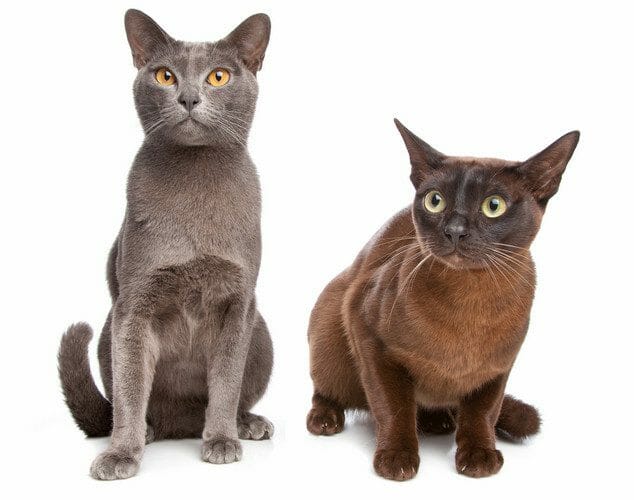
Burmese Cat Personality
The Burmese cat temperament is described as playful, energetic, intelligent, trusting, and outgoing. These felines enjoy cuddling on a lap but also love an energetic game of fetch. Many refer to these felines as being “dog-like” as they will follow their humans from room to room. They like to be involved in all activities and expect to sleep with their humans. True to their Siamese roots, they are chatty, with a voice described as raspy, soft, and rumbling. These felines will tell their owners about their day and express their feelings and opinions.
This playful personality is not limited to Burmese kittens. The desire to play and entertain will last throughout their lives. These felines crave attention and praise for their athletic feats. They may be stubborn if they do not feel like they are being given enough attention.
Female Burmese tend to have stronger personalities than males—demanding to be the center of attention and acting as a vocal member of the household. By contrast, males tend to be more relaxed, docile, and quieter.
The Burmese are good with children and will usually tolerate a cat-friendly dog. They will do best if they have a companion to play with at home.
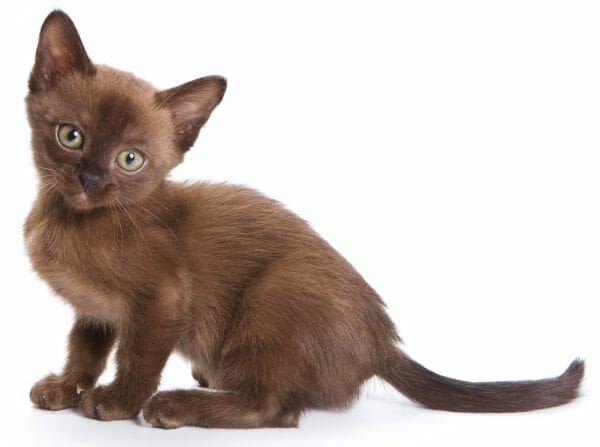
Burmese Cat Characteristics
The first thing to know about this breed is that there are two distinct types: the European Burmese cat and the American Burmese cat. The primary difference relates to the shape and size of the head. However, most registries do not treat them as separate breeds.
The European Burmese cat (also called a “traditional” Burmese) is the slenderer of the two types, with a wedge-shaped head and longer muzzle, small pointy ears, and almond-shaped eyes. By contrast, the American Burmese Cat (also called a “contemporary” Burmese) is stockier with a wider head, flatter muzzle, rounder eyes, and ears that are slightly wider at the base than the European. Eye color in both is typically gold or yellow.
Regardless of type, the coat is always short and silky and in a single solid color. These felines are considered to be medium-sized cats with a muscular and sturdy build.
Burmese Cat Size
- Weight: Males weigh between 8 and 12 pounds, and females weigh from 6 to 10 pounds
- Height: These felines can be 10 to 12 inches tall
- Length: Typically between 15 and 18 inches
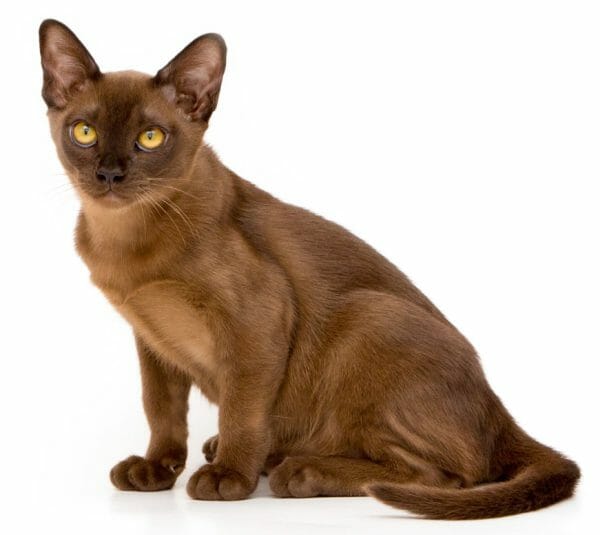
Are Burmese Cats Hypoallergenic?
Although no feline is completely hypoallergenic, some breeds produce fewer allergens than others, including pet dander. However, at least 10% of the population is allergic to a protein called Fel d 1, which is found in cat saliva. All that being said, the Burmese is considered to be a feline that causes fewer problems with allergies than other breeds.
Burmese Cat Colors
This breed’s coat is short and silky and comes in a range of colors, including:
- Sable/Rich Dark Brown
- Champagne/Warm Beige/Light Brown
- Blue/Medium Gray with Fawn Undertones
- Platinum/Pale Gray with Fawn Undertones
- Lilac (Diluted Chocolate Color)
Some cat associations allow for tortoiseshell, red, and cream coats, but these colors are more typical for the European type.
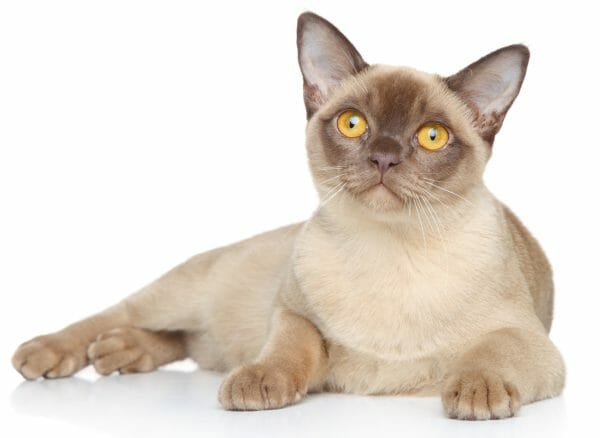
Facts About Burmese Cats
Below are some interesting facts about the Burmese cat breed.
- Unlike other felines that are skittish around strangers, Burmese are very trusting—making them easy prey for predators. For this reason, it is recommended that these kittens and cats live indoors or only venture outside when closely supervised.
- Burmese were used to develop other cat breeds, most notably the Bombay and the Burmilla.
- These felines are heavier than they look, which has led them to be referred to as “bricks wrapped in silk.”
- According to legend, this breed descended from a cat breed once worshipped in Burmese temples and were believed to be the embodiment of gods.
- According to a 2008 study at the University of California-Davis, the Burmese has the second-lowest level of genetic diversity among cat breeds. This has led to smaller litters, smaller adults, less hearty kittens, and issues with the immune system. As a result, several breeding councils recommend using the Bombay, Tonkinese, and Siamese cats to increase genetic diversity and healthier felines.
- The Burmese cat price can range from $450 to $3,000 for a “show-worthy” feline.
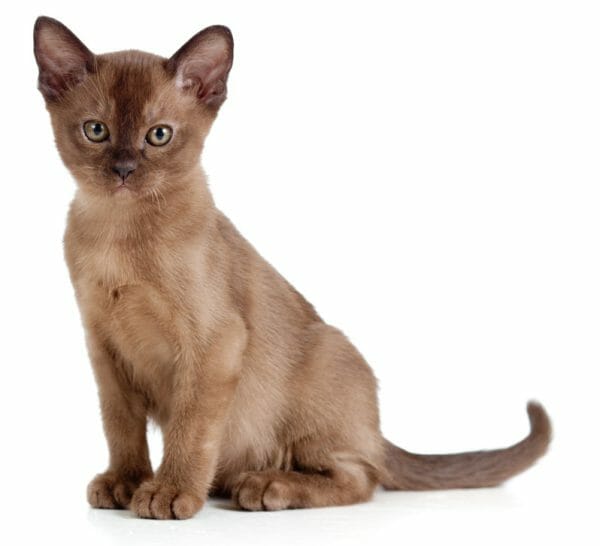
History and Background
Burmese cats originated in Burma (now known as Myanmar). Known as “copper cats,” they lived in southeast Asia for centuries. It is believed the breed is mentioned in an ancient book called “The Cat-Book of Poems,” which was written sometime during the Ayutthaya period (1350-1767).
However, the modern history of the Burmese cat breed can be traced to one cat named Wong Mau. Wong Mau was brought to the United States in the 1920s or 1930s and given to Dr. Joseph Thompson—a breeder of Siamese cats. Wong Mau was described as a chocolate-colored cat. When Thompson bred Wong Mau with a seal-point Siamese, some of the kittens looked like their mother but others look like Siamese.
After breeding Wong Mau with one of her brown-colored kittens, Thompson produced more brown kittens with no points. These kittens became the foundation of the modern-day Burmese breed. Subsequent breeding produced kittens with blue, chocolate, and lilac coloring in addition to the original sable color.
In 1936, the Cat Fancier’s Association (CFA) began registering the breed but did not fully recognize the breed until 1957. This delay was due, in part, to the CFA suspending the registration of Burmese cats between 1947 and 1953 until breeders stopped crossing Burmese and Siamese felines. (It was this cross-breeding effort that led to the development of the Tonkinese cat.)
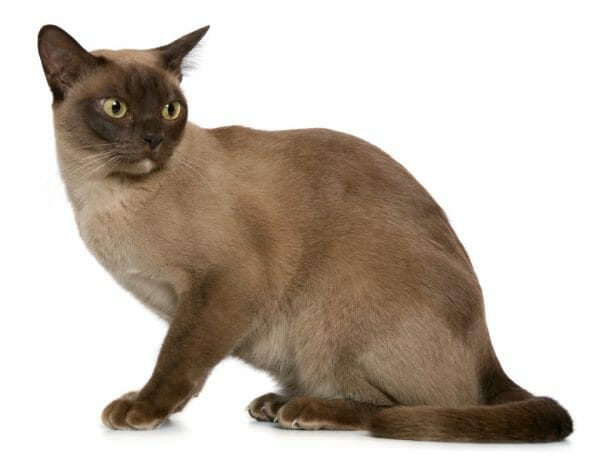
Caring for the Burmese Cat Breed
Grooming Requirements
A Burmese’s silky coat does not shed much and requires only an occasional brushing. Use a soft cloth to remove any loose hair and distribute oils in the skin. Other grooming requirements include trimming the nails regularly and keeping the ears clean.
Exercise
With their playful personalities, most Burmese get enough exercise through play. However, these felines love to jump and climb so a sturdy cat tree is a must. Games of fetch with a favorite toy are another favorite, as are interactive toys such as teasers and laser pointers. Their intelligence also makes them a good fit for interactive puzzle toys.
Their curious nature can sometimes lead to trouble, such as opening cabinets to see what is inside. Therefore, be sure to catproof any cupboards containing items that could be dangerous.
Health Issues
The Burmese cat lifespan averages 10 to 16 years. However, as with all felines, they require routine check-ups with a veterinarian and should be protected with all the recommended core vaccines, including the FIV vaccine. Owners can stave off obesity by providing high-quality cat food.
Although Burmese are generally healthy, possible health concerns include:
- Diabetes mellitus
- Craniofacial deformities
- Flat-chested kitten syndrome
- Glaucoma
- Feline hyperesthesia syndrome (extreme sensitivity of an area of a cat’s skin)
- Genetic hypokalemia (which can lead to low potassium in the blood)
- Kinked tail
- Congenital peripheral vestibular disease
- Elbow osteoarthritis
- Amyloidosis




